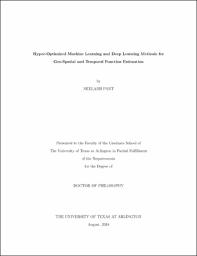
ATTENTION: The works hosted here are being migrated to a new repository that will consolidate resources, improve discoverability, and better show UTA's research impact on the global community. We will update authors as the migration progresses. Please see MavMatrix for more information.
Show simple item record
| dc.contributor.advisor | Elmasri, Ramez | |
| dc.creator | Pant, Neelabh | |
| dc.date.accessioned | 2019-02-08T17:52:00Z | |
| dc.date.available | 2019-02-08T17:52:00Z | |
| dc.date.created | 2018-08 | |
| dc.date.issued | 2018-08-13 | |
| dc.date.submitted | August 2018 | |
| dc.identifier.uri | http://hdl.handle.net/10106/27672 | |
| dc.description.abstract | Owing to a high degree of freedom in human mobility, accurate modelling/estimation of human mobility function remains a challenge. Numerous work in the literature have tried to address the challenge using various traditional machine learning methods on spatio-temporal attributes of data. We compare the use of Varied-K Means clustering, Hidden Markov Model techniques, feed forward neural networks, recurrent neural networks (RNN) and Long Short Term Recurrent Neural Networks (LSTM) to predict a user's future movement based on the user's past historical data. Although several techniques were proposed to predict a user's movement, not many have concentrated on a user's location based on weekday and time period within the day, as well as other features such as weather conditions (for example, temperature and precipitation). We introduce machine learning and deep neural network models using regression and classification techniques that can answer day-specific queries like "Where is the user most likely to be on a specific day of the week", day-time specific queries like "Where is the user most likely to be on a specific day of the week and time of the day" or spatio-temporal-weather queries like "The user is currently at a specific location with temperature of 70 degree and precipitation < 0.1, where would the user most likely to travel next given a day of the week and time of the day". Our deep learning classifier gives an average classification accuracy of 88%, which is almost 1.4 times better than other traditional machine learning methods. Deep learning regression's loss constantly keeps on decreasing as we train the model more.
We then shift our domain from geospatial data to financial data by introducing the famous problem of predicting future stock prices and future currency exchange rates. Researchers have done extensive work in creating models to predict stock prices but to the best of our knowledge most of the works have not shown techniques to optimize the hyperparameters and find "the best" model out of all the possible models to predict stock prices as close as possible. In this work we have worked on a meta-heuristic hyperparameter optimization technique called Genetics Algorithm / Evolutionary Algorithm through which we have selected the best model for a specific kind of problem. We also make use of the sliding window technique to capture the patterns within the data for better prediction. We decide the size of window more by calculating the partial-auto-correlation between the data to calculate the best window size. In our temporal analysis we chose to predict future Apple stock prices using technical and fundamental analysis (hybrid approach). By making use of hyperparameter optimization using genetics we try to compare different artificial neural networks among themselves and try to find the best model with the right hyperparameters for a certain kind of problem. Our method also determines the most important features (parameters) for the accurate prediction of future stock prices. | |
| dc.format.mimetype | application/pdf | |
| dc.language.iso | en_US | |
| dc.subject | LSTM | |
| dc.subject | RNN | |
| dc.subject | Neural networks | |
| dc.subject | Location prediction | |
| dc.subject | Stocks prediction | |
| dc.subject | Currency prediction | |
| dc.subject | Optimization | |
| dc.subject | Genetics | |
| dc.subject | Clustering | |
| dc.subject | K-means | |
| dc.title | Hyper-optimized Machine Learning and Deep Learning Methods For Geo-spatial and Temporal Function Estimation | |
| dc.type | Thesis | |
| dc.degree.department | Computer Science and Engineering | |
| dc.degree.name | Doctor of Philosophy in Computer Science | |
| dc.date.updated | 2019-02-08T17:52:01Z | |
| thesis.degree.department | Computer Science and Engineering | |
| thesis.degree.grantor | The University of Texas at Arlington | |
| thesis.degree.level | Doctoral | |
| thesis.degree.name | Doctor of Philosophy in Computer Science | |
| dc.type.material | text | |
| dc.creator.orcid | 0000-0003-0196-4891 | |
Files in this item
- Name:
- PANT-DISSERTATION-2018.pdf
- Size:
- 5.033Mb
- Format:
- PDF
This item appears in the following Collection(s)
Show simple item record


